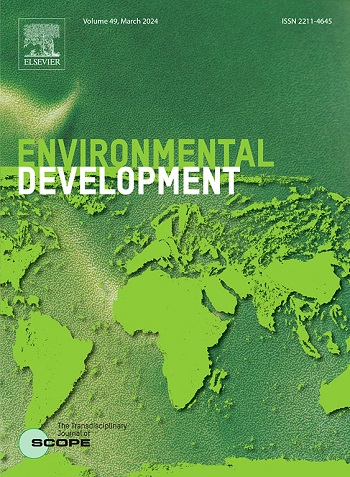中国黄土高原沟壑区生产-生活-生态空间的潜在冲突诊断、模拟优化与协调
IF 4.7
2区 环境科学与生态学
Q2 ENVIRONMENTAL SCIENCES
引用次数: 0
摘要
黄土高原沟壑区一直是生态脆弱的农业区。这些地区在经济发展过程中往往面临生产-生活-生态空间矛盾激化的共性问题,迫切需要系统的空间治理。本研究针对生产-生活-生态空间的潜在冲突,创新性地提出了 "识别诊断-模拟优化-协同治理 "的全过程技术框架,并以黄土高原沟壑区的华池县为例进行了实证研究。在此框架下,分析了研究区生产、生活、生态空间的转移规律;完善了 "多维度+多目标 "的空间适宜性评价指标体系;利用冲突判定矩阵确定了潜在空间冲突的范围、规模、类型和强度;进行了生态保护优先和社会民生发展优先两种情景下的空间优化模拟,设计了整体空间优化方案;提出了基于公共空间治理理论的空间协同治理策略。研究表明,该框架对研究领域具有较好的适用性,更能直接指导后续的空间规划和政策实践。华池县生产空间与生态空间的潜在冲突最为普遍,生活空间与生产空间的潜在冲突强度最大,生活空间与生态空间的潜在冲突风险呈上升趋势。协调空间潜在冲突,需要建立 "目标+协作+调整 "的纵向配置型空间功能协调链,以及 "配置+协作+平衡 "的横向协商型空间配置协调链,形成 "双纵双横 "的空间协调框架。本文章由计算机程序翻译,如有差异,请以英文原文为准。
Potential conflict diagnosis, simulation optimization and coordination of production-living-ecological space in gully areas of the Loess Plateau, China
The gully areas on the Loess Plateau have always been ecologically fragile agricultural areas. These areas often face the common problem of intensified conflicts in production-living-ecological space during economic development, and there is an urgent need for systematic spatial governance. This study innovatively developed a full process technical framework of “identification diagnosis - simulation optimization - coordinated governance” for potential conflicts in the production-living-ecological space, and used Huachi County in the gully area of the Loess Plateau as an example for empirical research. Under this framework, we analyzed the transfer patterns of production, living, and ecological space in the research area; Improved the spatial suitability evaluation index system of “multi-dimensional + multi-objective”; The conflict determination matrix was used to identify the scope, scale, type, and intensity of potential spatial conflicts; We conducted spatial optimization simulations under two scenarios: prioritizing ecological protection and prioritizing social and livelihood development, and designed an overall spatial optimization plan; Propose spatial collaborative governance strategies based on the theory of public space governance. Research shows that this framework has good applicability for the research area and is more direct for guiding subsequent spatial planning and policy practice. The potential conflict between production space and ecological space in Huachi County is the most common, the potential conflict intensity between living space and production space is the largest, and the potential conflict risk between living space and ecological space is rising. To coordinate potential conflicts in space, it is necessary to establish a vertical allocation type of spatial function coordination chain of “goal + collaboration + adjustment”, as well as a horizontal negotiation type of spatial configuration coordination chain of “allocation + cooperation + balance”, forming a “double vertical and double horizontal” spatial coordination framework.
求助全文
通过发布文献求助,成功后即可免费获取论文全文。
去求助
来源期刊

Environmental Development
Social Sciences-Geography, Planning and Development
CiteScore
8.40
自引率
1.90%
发文量
62
审稿时长
74 days
期刊介绍:
Environmental Development provides a future oriented, pro-active, authoritative source of information and learning for researchers, postgraduate students, policymakers, and managers, and bridges the gap between fundamental research and the application in management and policy practices. It stimulates the exchange and coupling of traditional scientific knowledge on the environment, with the experiential knowledge among decision makers and other stakeholders and also connects natural sciences and social and behavioral sciences. Environmental Development includes and promotes scientific work from the non-western world, and also strengthens the collaboration between the developed and developing world. Further it links environmental research to broader issues of economic and social-cultural developments, and is intended to shorten the delays between research and publication, while ensuring thorough peer review. Environmental Development also creates a forum for transnational communication, discussion and global action.
Environmental Development is open to a broad range of disciplines and authors. The journal welcomes, in particular, contributions from a younger generation of researchers, and papers expanding the frontiers of environmental sciences, pointing at new directions and innovative answers.
All submissions to Environmental Development are reviewed using the general criteria of quality, originality, precision, importance of topic and insights, clarity of exposition, which are in keeping with the journal''s aims and scope.
 求助内容:
求助内容: 应助结果提醒方式:
应助结果提醒方式:


